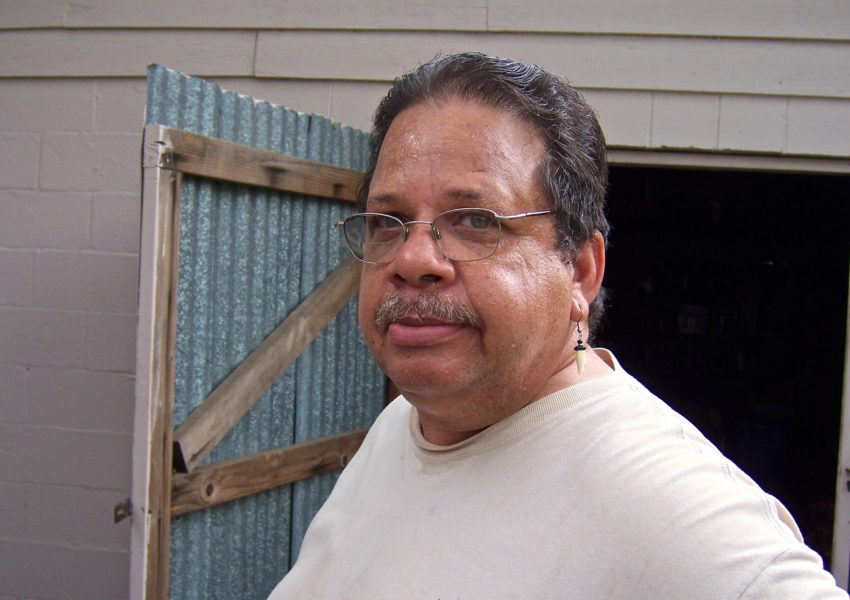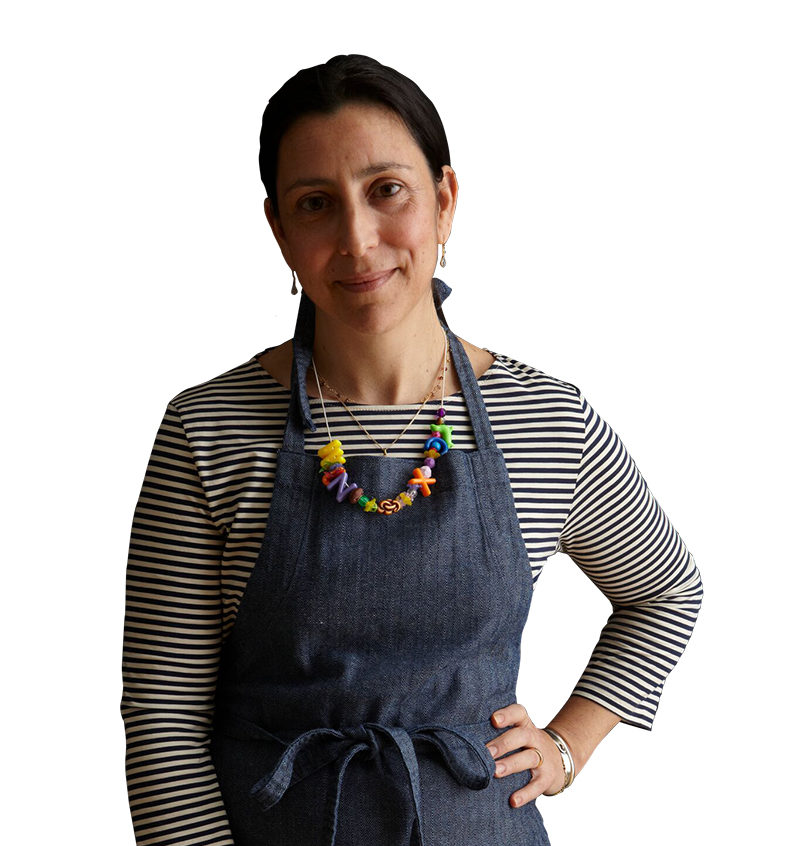< Back to Oral History project: Southern Gumbo Trail
ORAL HISTORY
Billy Gruber
For every roux-based gumbo out there, each cook has a certain kind of roux they like to make. Some people prefer to use a more subtle peanut butter-colored roux. Others prefer the rich nuttiness of a darker roux. Billy Gruber, chef and owner of Liuzza’s by the Track in New Orleans, calls his roux a black roux. The richness of this dark, dark roux adds both flavor and color to the finished gumbo. Making such a dark roux takes time and patience, though. Not a lot of folks choose to create it for that reason. Many prefer to make a roux over low heat, but working like that, it could take almost an hour to darken fully. Billy works with the highest heat possible and creates a black roux in twelve minutes. Making a roux can also be a dangerous task; Billy likens roux-making to working with Cajun Napalm. But he’s mastered his technique. Here’s how he does it.
Amy Evans: Monday, August 7th 2006, Amy Evans for Southern Foodways Alliance with Billy Gruber again, and we’re at Liuzza’s by the Track, and he is making a roux.
Billy Gruber: Yeah, in the old days, as we talked before they—it took those ladies and gentlemen an hour-and-a-half—hour and forty-five minutes to do a roux. So I think that’s where the beginning of cooking ambidextrous came in because they had to switch hands. [Laughs] You know, you can’t do something like that for an hour-and-a-half with one arm so…I [whisk the roux]—right hand, I start off with, you know, you do—I usually do a counterclockwise circular thing and then you’ll go clockwise as not to get boring and tired. And then after a little while you might switch hands, you know.
Right now what I’m doing—the pan is just being heated. I’m going to put the oil in the pan now and we’re not going to look at that pan or touch it ‘til it’s smoking. That will mean it passes 222—220-degrees boiling point; it passes it. You know, it’s going to be getting up to 300 and 400 degrees. I’ll put three cups of flour on the side and—. All right; and I always think it’s better to have a little more flour than oil. Don’t ask me
why. [Laughs]…White flour. You want a clean, clean pan because if anything gets in there—anything can cause this to burn. And I’m getting it at such a high temperature that one little burn and the whole thing is gone. So you’ve wasted your time; you’ve got to clean it up and you’ve got to do this, blah-blah-blah, you know. It’s crazy.
So you said the other day that you don’t like people bugging you while you’re making your roux, so I’m feeling a little—a little dangerous standing here. [Laughs] But would you mind talking while you’re doing it and telling me what you’re doing?
No, I can do that. Yeah, just—I don’t want to leave it. I don’t want anybody—if the phone rings, I might not even answer it…But it’s, you know—like I say, it’s going to take ten to twelve minutes, maybe and—or anyway, it just depends on how, you know, when you—and you’ll see what I’m talking about when we’re in the middle of it. It starts out white and, like I said, when you want—it’s not smoking yet. But you see how long this [vegetable oil in the pan] has been on full boil.
Yeah, a few minutes—yeah.
Okay, that was only three cups [of oil], so don’t stick your finger in to see if it’s hot…But anyway, when it gets going—so when you do that, you’ve got to be very quick to—and what I’ve done is I usually do it with four cups, and then when I do four cups of flour, four
 cups of oil, that will put it up to here [points to the top edge of the pan he is using], so I don’t want to do that while you’re around. I like to do it—and I tell everybody to get out of the way because it—it’s Cajun Napalm, and if it touches you, it will burn you. It will hurt. It will go through, you know.
cups of oil, that will put it up to here [points to the top edge of the pan he is using], so I don’t want to do that while you’re around. I like to do it—and I tell everybody to get out of the way because it—it’s Cajun Napalm, and if it touches you, it will burn you. It will hurt. It will go through, you know.
So this batch you’re doing as a demo you’ll be able to use this week for [making] gumbo?
Yeah, I’ll just do—do gumbo, do like I said—we can use it for anything—etouffee, there’s a lot of different dishes. You know, like I say, you know, the—the pot, when I do gumbo—and I’ll show you in the back, but I do it on this burner here [points to a short single burner, which is to the left of the main stove] and the pot is about that big [gestures]; it’s twenty gallons.
 And it’s like three and a half-feet tall, something like that?
And it’s like three and a half-feet tall, something like that?
Yeah… I only use, like I said, three of these [large kitchen] spoons, you know, filled up, to go in it [a batch of gumbo]. So that’s not a lot, you know, but what it does is—is just a certain nuttiness and a—because if you taste that, you could taste oil and flour; that’s all it is. And it’s terrible tasting. But dissolved and done right, you know, it does—like I say, it gives some credence to it.
See [the oil smoking]? I’m going to put this [flour] in. [Pours four into the pan of hot oil and immediately begins stirring it with a whisk.] See? Look at the bottom. And you keep stirring it because if you let anything sit—I’ll shake the pot, and we’ll keep doing this because if one thing sticks, it’s going to burn. And—and it probably really sounds funny saying it’s going to burn when the finished product is, you know—it’s black, basically. But there’s a method to the madness. I’m not sure of the engineering and the—the chemistries but some people know it very
 well. But you can see right now it’s turning a little tan [in color]. And like I say, you do not ever leave the pot because you got the flame as high as you can. And what we’ll do—what it’s going to do now is it took the temperature down because oil was up, and then when you put the three cups of flour in it to match the three cups of oil, it brought the temperature back down. So now I don’t know how far to bring it down; I can’t assume that much, but it will go back up, and you’ll see it start to bubble again and it will start to change colors rapidly.
well. But you can see right now it’s turning a little tan [in color]. And like I say, you do not ever leave the pot because you got the flame as high as you can. And what we’ll do—what it’s going to do now is it took the temperature down because oil was up, and then when you put the three cups of flour in it to match the three cups of oil, it brought the temperature back down. So now I don’t know how far to bring it down; I can’t assume that much, but it will go back up, and you’ll see it start to bubble again and it will start to change colors rapidly.
Like I say, in the beginning you’ll see—that’s why I did it real quick; you don’t want to see anything stick. And you can see little brown flicks in it now.
What would you call that color that it is right now?
Tan. And I wouldn’t use it for anything. Some people might use it; you might use something like this to thicken up like roast beef gravy or something like that, where it’s not totally a lot of flour and oil taste yet. It’s just really a thickening
 agent now. A lot of people take stuff like this, stop it and put it on their—on the back of their kitchen shelf and they’ll use it if they have to thicken something up, you know—a meat or a chicken, you know. This would be perfect to thicken up a chicken gravy or you know—to make any of your chicken dishes—the Coq Au Vin or anything.
agent now. A lot of people take stuff like this, stop it and put it on their—on the back of their kitchen shelf and they’ll use it if they have to thicken something up, you know—a meat or a chicken, you know. This would be perfect to thicken up a chicken gravy or you know—to make any of your chicken dishes—the Coq Au Vin or anything.
See, here comes a point, and I’ll go this way [changes direction of stirring].
Counterclockwise. [Laughs]
I’m getting ready to go ambidextrous on you.
I’m waiting for you to get your whole body into it. [Laughs]
Yeah, it’s funny—the phone is all the way down there [at the other end of the bar], and most people know when they answer the phone and they see what I’m doing, they won’t even ask. They’ll just say, “He’ll call you back when he’s finished his roux.” That’s it. And being, like I said, everybody who knows
everything about food in New Orleans, everybody knows; they don’t even question it. “Aw, come on, let me talk to him.” They wouldn’t dare.
See it getting a little darker? I should have timed it. Let’s say we’re into it four minutes.
I’ve got a timer on this recorder here. It says three minutes [and] fifty seconds…And that should be an eight-minute roux? Is that what you said the other day?
Yeah, I generally try to do an eight-minute deal. See what I forgot to do?
Damn, I forgot to cut up an onion. So what I’m going to do is—and you can tell the people in case you forget that—and the onion is used—if you remember when
 I told you about it, it cools it down…So what I’m going to do is I’m going to stop cooking this probably about a minute, maybe, before I normally would. And I will keep stirring it so it won’t go over the limit and get burned. Because if you just—if I just took this off the stove and put it there [on the counter] and let it alone at a black thing [a black-colored roux], it—it would burn because it kept cooking, you know. So now we’re changing hands…And you can see it turning [color] now.
I told you about it, it cools it down…So what I’m going to do is I’m going to stop cooking this probably about a minute, maybe, before I normally would. And I will keep stirring it so it won’t go over the limit and get burned. Because if you just—if I just took this off the stove and put it there [on the counter] and let it alone at a black thing [a black-colored roux], it—it would burn because it kept cooking, you know. So now we’re changing hands…And you can see it turning [color] now.
Would this be peanut butter [color] about now?
Yeah. And what’s happening now, the—I don’t know if it’s physiological or whatever—it went from a very loose state, very liquid-y, okay, where the oil was more than the flour. Now it’s getting absorbed, the molecules of the flour and the oil and roux are kind of coming together. See how it’s getting thicker? Maybe you
 can’t see it, but you can feel it when you do it.
can’t see it, but you can feel it when you do it.
Oh, yeah.
So therefore it’s really, you know, getting into each other and the colors are marrying perfectly and—
Beautiful.
—and like I say, yeah, it’s kind of coming together. But it just turns—the thickness of it because they’re integrating each other, you know, the oil and the flour. I always like to say they’re marrying; they’re getting together—like couples, you know.
We’re at six-an-a-half minutes.
All right, I might go a little longer then. Call me a liar. Lot thicker now.
And then while I’m doing this—that’s one of the signs too, you’re—you’re feeling it; you’re feeling the bottom of the pot—pan because you don’t know if it’s sticking or not. So by doing this, you constantly have the feel of the bottom of the pan—it’s smooth. If it were to start sticking, you could feel it and then you would
 concentrate on that area and turn it down a little bit. But, you know, you can see it now accelerating—the color. In about another minute it’s going to be probably a really perfect etouffee look.
concentrate on that area and turn it down a little bit. But, you know, you can see it now accelerating—the color. In about another minute it’s going to be probably a really perfect etouffee look.
What color would you say we have now? Is this what you were calling mahogany [the other day]?
Yeah, yeah. This is an etouffee color—that’s it…Like now towards this point we’re getting ready to take it off. How much time we got?
You’re at eight [minutes], fifty-two [seconds].
Okay, nine minutes. It’s a cross between eight and ten…Okay, [in] thirty seconds we’ll pull this off.
What makes you say thirty seconds?
It’s a lot of smoke coming out and, like I said, it’s very close between done and burnt and, you know, you have to make that distinction. All right, I turned it off. What’s the time?
It is ten minutes and fifteen seconds.
Okay; so—. Turn it off. [Places the hot pan on the stainless steel counter.] See it still turning the color?
Yeah. And it would still be in pretty deep danger of thickening up and
 chunking up on you, then, at this point or no?
chunking up on you, then, at this point or no?
If I left it alone? You might be all right now; like I say, I got off where the heat is on the bottom and it should be, you know, all right. I always like, like I say, to control it. You put those onions in there, you’ll see, you know, kind of what I’m talking about. And you can see the separation of the oil and the whole product. That was what I took off the top. It will always separate—the oil, you know, like I say, will come—some of it won’t get married into the—the flour. So that’s—and later on after it cools down that’s when you, you know, pour it off the top because you don’t want to pour oil into any products you use. You just want to pour this mixture in. …And it’s still going to change a little bit more.
How long does it need to sit before you refrigerate it or anything?
 I’m going to let it sit because every once in a while I’ll stir it and make sure and I know—because I know we’re out of onions because I used the last one Saturday, and I won’t get them in until tomorrow morning early when I start cooking again.
I’m going to let it sit because every once in a while I’ll stir it and make sure and I know—because I know we’re out of onions because I used the last one Saturday, and I won’t get them in until tomorrow morning early when I start cooking again.
But you’re going to put this in the refrigerator eventually after it cools?
Yeah, in a little bit—yeah.
All right. Well, any final thoughts about your roux-making technique?
No, I guess it’s me and a couple thousand other people kind of use the same—I don’t know because I don’t—I haven’t asked people what they do.
Well when people talk about it, it seems so mysterious like it’s
 making a high meringue or something, and so you made it look so easy, it looks like there’s just absolutely nothing to it. But I know there is.
making a high meringue or something, and so you made it look so easy, it looks like there’s just absolutely nothing to it. But I know there is.
You know it’s—like I say the old days you know they’d go an hour and a half, hour and forty-five minutes and I couldn’t imagine [Laughs]—you know I could not imagine doing that…But you know it’s funny because you—you can tell now—you can understand now when I say—when somebody would go for this color—the black—and then if you didn’t know anything about how to do it and the temperature and the speed it’s done. A lot of people would probably go for it until it got to that color on the stove, and then by the time they took it off, I guarantee you, it would have been burnt. In other words, you’ve got to take it off before because it keeps cooking.













































